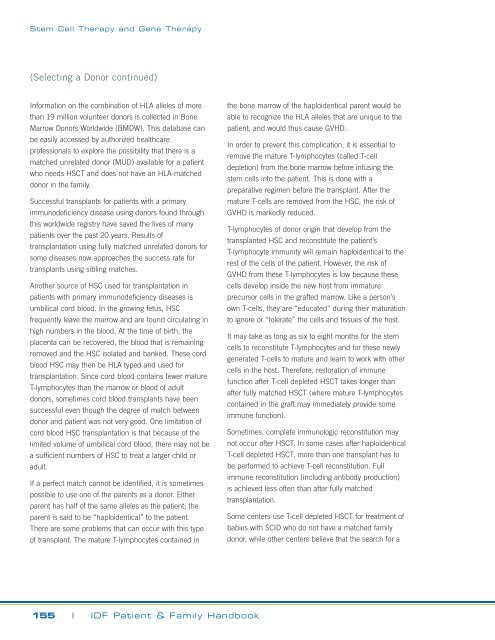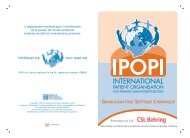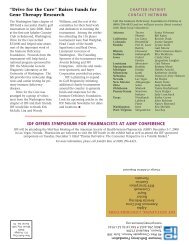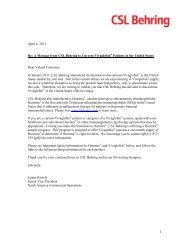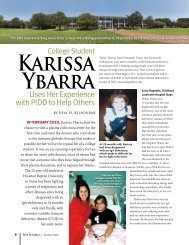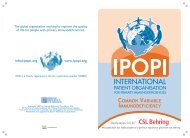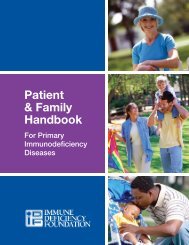Stem Cell Therapy and Gene Therapy
Stem Cell Therapy and Gene Therapy
Stem Cell Therapy and Gene Therapy
Create successful ePaper yourself
Turn your PDF publications into a flip-book with our unique Google optimized e-Paper software.
<strong>Stem</strong> <strong>Cell</strong> <strong>Therapy</strong> <strong>and</strong> <strong>Gene</strong> <strong>Therapy</strong><br />
(Selecting a Donor continued)<br />
Information on the combination of HLA alleles of more<br />
than 19 million volunteer donors is collected in Bone<br />
Marrow Donors Worldwide (BMDW). This database can<br />
be easily accessed by authorized healthcare<br />
professionals to explore the possibility that there is a<br />
matched unrelated donor (MUD) available for a patient<br />
who needs HSCT <strong>and</strong> does not have an HLA-matched<br />
donor in the family.<br />
Successful transplants for patients with a primary<br />
immunodeficiency disease using donors found through<br />
this worldwide registry have saved the lives of many<br />
patients over the past 20 years. Results of<br />
transplantation using fully matched unrelated donors for<br />
some diseases now approaches the success rate for<br />
transplants using sibling matches.<br />
Another source of HSC used for transplantation in<br />
patients with primary immunodeficiency diseases is<br />
umbilical cord blood. In the growing fetus, HSC<br />
frequently leave the marrow <strong>and</strong> are found circulating in<br />
high numbers in the blood. At the time of birth, the<br />
placenta can be recovered, the blood that is remaining<br />
removed <strong>and</strong> the HSC isolated <strong>and</strong> banked. These cord<br />
blood HSC may then be HLA typed <strong>and</strong> used for<br />
transplantation. Since cord blood contains fewer mature<br />
T-lymphocytes than the marrow or blood of adult<br />
donors, sometimes cord blood transplants have been<br />
successful even though the degree of match between<br />
donor <strong>and</strong> patient was not very good. One limitation of<br />
cord blood HSC transplantation is that because of the<br />
limited volume of umbilical cord blood, there may not be<br />
a sufficient numbers of HSC to treat a larger child or<br />
adult.<br />
If a perfect match cannot be identified, it is sometimes<br />
possible to use one of the parents as a donor. Either<br />
parent has half of the same alleles as the patient; the<br />
parent is said to be “haploidentical” to the patient.<br />
There are some problems that can occur with this type<br />
of transplant. The mature T-lymphocytes contained in<br />
the bone marrow of the haploidentical parent would be<br />
able to recognize the HLA alleles that are unique to the<br />
patient, <strong>and</strong> would thus cause GVHD.<br />
In order to prevent this complication, it is essential to<br />
remove the mature T-lymphocytes (called T-cell<br />
depletion) from the bone marrow before infusing the<br />
stem cells into the patient. This is done with a<br />
preparative regimen before the transplant. After the<br />
mature T-cells are removed from the HSC, the risk of<br />
GVHD is markedly reduced.<br />
T-lymphocytes of donor origin that develop from the<br />
transplanted HSC <strong>and</strong> reconstitute the patient’s<br />
T-lymphocyte immunity will remain haploidentical to the<br />
rest of the cells of the patient. However, the risk of<br />
GVHD from these T-lymphocytes is low because these<br />
cells develop inside the new host from immature<br />
precursor cells in the grafted marrow. Like a person’s<br />
own T-cells, they are “educated” during their maturation<br />
to ignore or “tolerate” the cells <strong>and</strong> tissues of the host.<br />
It may take as long as six to eight months for the stem<br />
cells to reconstitute T-lymphocytes <strong>and</strong> for these newly<br />
generated T-cells to mature <strong>and</strong> learn to work with other<br />
cells in the host. Therefore, restoration of immune<br />
function after T-cell depleted HSCT takes longer than<br />
after fully matched HSCT (where mature T-lymphocytes<br />
contained in the graft may immediately provide some<br />
immune function).<br />
Sometimes, complete immunologic reconstitution may<br />
not occur after HSCT. In some cases after haploidentical<br />
T-cell depleted HSCT, more than one transplant has to<br />
be performed to achieve T-cell reconstitution. Full<br />
immune reconstitution (including antibody production)<br />
is achieved less often than after fully matched<br />
transplantation.<br />
Some centers use T-cell depleted HSCT for treatment of<br />
babies with SCID who do not have a matched family<br />
donor, while other centers believe that the search for a<br />
155 | IDF Patient & Family H<strong>and</strong>book


